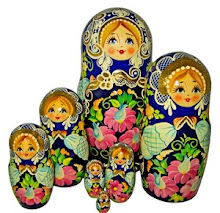Timeline: Russian Federation
>> Thursday, December 11, 2008
Timeline: Russian Federation
Marked by the dissolution of the USSR and conflict in Chechnya
by David Johnson
ယင္းေနရာမွ ကူးယူသည္။
1991
Soviet Union disintegrates; 14 former republics become independent nations. Russian Federation formed; Boris Yeltsin appointed, later elected president
1992
Yeltsin ends supremacy of Communist Party, privatizes state-run enterprises, guarantees free press; businessmen, mobsters begin to take over economy, massive corruption sets in
1994-1996
Russia invades breakaway province of Chechnya; humiliated, withdraws with heavy casualties
1998
Russian stock market crashes, economy collapses
1999-2000
Second Chechen war, Russia crushes rebels; Vladimir Putin elected president
2000
Russian Orthodox Church bestows sainthood on Czar Nicholas and 1,000 others killed by Communists
2002
Chechen rebels seize a crowded Moscow theater and detain 763 people. Armed and wired with explosives, the rebels demand that the Russian government end the war in Chechnya. Government forces storm the theater after releasing a gas into the theater that kills not only all the rebels but more than 100 hostages.
2003
Chechens vote in a referendum that approves a new regional constitution making Chechnya a separatist republic within Russia. Agreeing to the constitution means abandoning claims for complete independence, and the new powers accorded the republic are little more than cosmetic.
2004
President Vladimir Putin is reelected with 70% of the vote. In September, dozens of heavily armed guerrillas seize a school in Beslan, near Chechnya, and hold about 1,100 young schoolchildren, teachers, and parents hostage. Hundreds of hostages are killed, including about 156 children.
2006
Chechen warlord Shamil Basayev, who was responsible for the horrific Beslan terrorist attack, is killed.
2007
Former president Boris Yeltsin dies in April.
2008
Dmitri Medvedev is elected president, succeeding Vladimir Putin. Medvedev nominates Putin as prime minister.
Russia enters the conflict between Georgia and a breakaway region, South Ossetia, with troops and tanks pouring into South Ossetia to support the region in August.
Russia intensifies its involvement, moving troops into Abkhazia, another breakaway region, and launching airstrikes at Tbilisi, the capital of Georgia. Dozens are killed, hundreds are wounded, and thousands of people in South Ossetia flee their homes.
President Medvedev orders an end to military action in Georgia, although sporadic fighting continues.
Russian tanks occupy Gori, a strategic town 40 miles from Tbilisi, and hundreds of Russian soldiers cross the border into South Ossetia. Leaders of EU nations, the United States, and NATO have warn Russia to end the conflict in Georgia.
Medvedev signs a revised cease-fire, but Russian troops remain in Georgia. Georgia demands that a provision in the original agreement be amended to allow only those Russian peacekeepers who were in Georgia before the hostilities began to remain. The deal is tentative at best.






0 comments:
Post a Comment